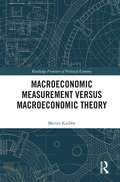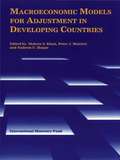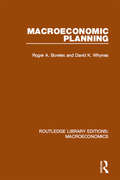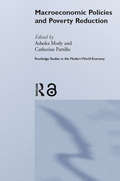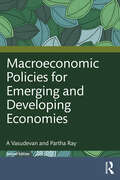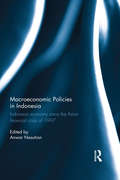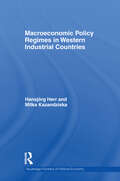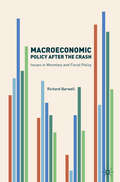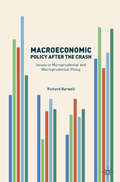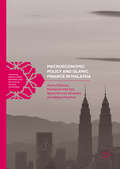- Table View
- List View
Macroeconomic Implications of Financial Dollarization: The Case of Uruguay
by Gaston Gelos Alejandro Lpez Meja Marco A. Pin-FarahA report from the International Monetary Fund.
Macroeconomic Inequality from Reagan to Trump: Market Power, Wage Repression, Asset Price Inflation, and Industrial Decline (Studies in New Economic Thinking)
by Lance TaylorFor five decades, rising US income and wealth inequality has been driven by wage repression and production realignments benefitting the top one percent of households. In this inaugural book for Cambridge Studies in New Economic Thinking, Professor Lance Taylor takes an innovative approach to measuring inequality, providing the first and only full integration of distributional and macro level data for the US. While work by Thomas Piketty and colleagues pursues integration from the income side, Professor Taylor uses data of distributions by size of income and wealth combined with the cost and demand sides, flows of funds, and full balance sheet accounting of real capital and financial claims. This blends measures of inequality with national income and product accounts to show the relationship between productivity and wages at the industry sector level. Taylor assesses the scope and nature of various interventions to reduce income and wealth inequalities using his simulation model, disentangling wage growth and productivity while challenging mainstream models.
Macroeconomic Issues Today: Alternative Approaches
by Robert B. Carson Wade L. Thomas Jason HechtNow revised and updated to reflect critical changes in economic policy since the last edition, Macroeconomic Issues Today, Eighth Edition, provides Conservative, Liberal, and Radical interpretations and solutions for seven current macroeconomic issues, including all-new coverage of the Social Security debate. An instructor's manual with a test bank and discussion questions is available to professors who adopt the text, and PowerPoint downloads are available as teaching aids.
Macroeconomic Issues and Policies in the Middle East and North Africa
by International Monetary FundThe Middle East and North African countries are at a crucial point in their reform process. Several have made efforts to strengthen demand management, rationalise price structures, liberalise exchange and trade regimes. Whilst these steps have contained inflation, growth has remained weak, and in many countries this combination has worsened already high levels of unemployment and poverty. This book draws on recent research to show how the countries are addressing the challenges. It stresses that self-sustaining and faster growth can be achieved through structural reforms and closer collaboration with the international community.
Macroeconomic Linkage: Savings, Exchange Rates, and Capital Flows
by Takatoshi Ito Anne O. KruegerThis volume explores East Asia's macroeconomic experience in the 1980s and the economic impact of East Asia's growth on the rest of the world. The authors explore the causes of capital flows, changes in trade balances, and exchange rate fluctuations in East Asia and their effects on other countries. These fourteen papers are organized around four themes: the overall determinants of growth and trading relations in the East Asian region; monetary policies in relation to capital controls and capital accounts; the impact of exchange rate behavior on industrial structure; and the potential for greater regional integration. The contributors examine interactions among exchange rate movements, trade balances, and capital flows; how government monetary policy affects capital flows; the effect of exchange rates on industrial structure, inventories, and prices; and the extent of regional integration in East Asia.
Macroeconomic Management: Programs and Policies
by Mohsin S. Khan Saleh M. Nsouli Chorng-Huey WongEstablished in 1964, the IMF Institute provides training on macroeconomic management to officials of IMF member countries, on issues including: financial programming and policies, monetary and exchange operations, public finance, financial sector issues and macroeconomic statistics. This book considers the key issues addressed by the Institute's programme of economic management training, which policymakers need to consider when managing national economies.
Macroeconomic Measurement Versus Macroeconomic Theory (Routledge Frontiers of Political Economy)
by Merijn KnibbeIdeally, scientific theory and scientific measurement should develop in tandem, but in recent years this has not been the case in economics. There used to be a time when leading economists, or their students, established or led statistical offices and took care that the measurements were consistent with the theory (and vice versa). Not anymore. Macroeconomic theorists and macroeconomic statisticians do not even speak the same language any longer. They do use the same words, such as ‘consumption’, ‘investments’ or ‘unemployment’ but the meanings can often be different. This book maps the differences between macroeconomic theory and measurement and explores them in some detail while also tracking their intellectual, historical and, in some cases, ideological origins. It also explores the possible policy implications. In doing so, the book draws on two separate strands of literature which are seldom used in unison: macro-statistical manuals and theoretical macro-papers. By doing so, the book contributes to the effort to bridge the gap between them without compromising on the idea that a meaningful science of economics should, in the end, be based upon individual people and households and their social and cultural embedding instead of a ‘representative consumer’, or Robinson Crusoe figure. This work is essential reading for students, economists, statisticians, and professionals.
Macroeconomic Modelling of R&D and Innovation Policies (International Economic Association Series)
by Ufuk Akcigit Cristiana Benedetti Fasil Giammario Impullitti Omar Licandro Miguel Sanchez-MartinezThis open access book encompasses a collection of in-depth analyses showcasing the challenges and ways forward for macroeconomic modelling of R&D and innovation policies. Based upon the proceedings of the EC-DG JRC-IEA workshop held in Brussels in 2017, it presents cutting-edge contributions from a number of leading economists in the field. It provides a comprehensive overview of the current academic and policy challenges surrounding R&D as well as of the state-of-the-art modelling techniques.The book brings to the forefront outstanding issues related to the assessment of the macroeconomic impact of R&D policies and its modelling. It speaks to the rising importance of R&D and innovation policy, and the proliferation of macroeconomic models featuring endogenous technological change.The contents of this book will be of interest to both academic and policy audiences working in the fields of R&D and innovation.
Macroeconomic Modelling, Economic Policy and Methodology: Economics at the Edge (Routledge Frontiers of Political Economy)
by Mikael Randrup ByrialsenDemonstrating that there are (superior) alternatives to the modern macroeconomic mainstream and its DSGE (dynamic stochastic general equilibrium) models, this book presents the cutting edge in macroeconomic modelling, economic policy, and methodology from the perspective of heterodox economic thinking. The first part of the book explores methodological issues, advocating for a stronger ethical consideration in macroeconomics and for the adoption of a strategy of pluralism to ensure that macroeconomic theory is capable of adapting to real-world issues. The second part highlights recent trends in empirical Stock-Flow Consistent models by collecting a group of the most well-developed empirical models of five different economies: the Danish, the Dutch, the French, the Italian, and the Argentinian models. In all five cases, the models are used to discuss various policy aspects of the individual economies. Finally, the book explores issues of macroeconomic policy which are largely neglected by mainstream economists including financial (in)stability and macro imbalances. The book emphasizes the need for investigating sectoral balances, which are crucial elements for investigating imbalances from the heterodox perspective. This book will be of significant interest to students and scholars of macroeconomics, economic modelling, economic methodology and heterodox economics more broadly.
Macroeconomic Models for Adjustment in Developing Countries
by Mohsin S. Khan Peter J. Montiel Nadeem U. HaqueA report from the International Monetary Fund.
Macroeconomic Paradigms and Economic Policy
by Giovanni Di Bartolomeo Nicola Acocella Andrew Hughes Hallett Acocella, Nicola and Di Bartolomeo, Giovanni and Hughes Hallett, AndrewThe recent financial crisis has demonstrated the dangers of ignoring the factors that led to previous crises, and the effectiveness of the policies designed to deal with them. Over time, these macroeconomic policies have evolved, oscillating between state intervention and a free-market approach. Following a story that runs from the pre-Great Depression era up until the Financial Crisis of 2007–11, this book reveals an intimate connection between new macroeconomic ideas and policies and the events in the real economy that inspired them. It does this in an accessible, easy-to-follow style, first by focusing on the developments of economic theories and policies, and then by concentrating on the design of domestic and international institutions and economic governance. Written by three leading experts on the history of economic policy, the book is ideal for graduates and undergraduates studying macroeconomics, monetary policy and the history of economic thought.
Macroeconomic Patterns and Monetary Policy in the Run-up to Asset Price Busts
by Pau Rabanal Prakash Kannan Alasdair ScottA report from the International Monetary Fund.
Macroeconomic Performance in a Globalising Economy
by Robert Anderton Geoff KennyThe process of globalisation has been ongoing for centuries, but few would doubt that it has accelerated and intensified in recent decades. This acceleration is evidenced as much by the strong synchronicity in the rapid transmission of financial crises starting in late 2007 as it is by the decade of almost unprecedented growth in international trade and financial market liberalisation that preceded it. This book shows how the international economy has become more connected via increased production, trade, capital flows and financial linkages. Using a variety of methodologies, including both panel econometrics and DSGE modelling, a team of experts from academia, central banks and the IMF examine how this increased globalisation has affected competitiveness, productivity, inflation and the labour market. This timely contribution to the globalisation literature provides a longer-term perspective while also evaluating some of the potential implications for policy makers, particularly from a European perspective.
Macroeconomic Planning (Routledge Library Editions: Macroeconomics #Vol. 14)
by Roger Bowles David WhynesThis volume, originally published in 1979, examines systematically the nature of control in both capitalist and socialist economies, develops a theoretical and applied framework which can embrace both macroeconomics and plannng and demonstates the essential unity of all forms of macroeconomic planning by the consistent application of basic economic principles. <P><P>Firstly, the authors establish why societies feel a need for government control and examine the mechanisms by which such social decisions are reached. Next they examine the nature of economic data, the modelling of economic systems nad a review of practical policy goals and instruments. The book then reviews the basic theory of optimisation and elaborates it in the context of planning for growth, for stabilisation and under uncertainty. It closes with an analysis of practical planning based on French and Soviet experience.
Macroeconomic Policies IN An Interdependent World
by Paul R. Masson Jacob A. Frenkel Ralph C. BryantA report from the International Monetary Fund.
Macroeconomic Policies and Poverty: Stylized Facts And An Overview Of Research (Routledge Studies in the Modern World Economy #No. 01/135)
by Catherine Pattillo Ashoka ModyIn this volume, world-renowned contributors, including Martin Ravallion, Michael Kremer and Robert Townsend, deal with the institutional characteristics of poverty resulting from the time pattern of aid, the nature of financial systems and the political economy of budgetary decisions. Going beyond the traditional literature on poverty, this original book deals with themes of broad interest to both scholars and policymakers in a clear yet technically sophisticated manner. Departing from conventional methods employed in poverty studies, these innovative essays enquire into the institutional characteristics of poverty, and using current case studies, they examine the crucial idea that periods of crises seriously affect poverty.
Macroeconomic Policies for Emerging and Developing Economies
by Partha Ray A VasudevanThis book examines the relevance of the concepts and hypotheses of macroeconomics in the contemporary world. It discusses the current debates on theory and practices of macroeconomic policies with a focus on developing economies emerging from the impact of Covid-19 pandemic. The volume advocates for a symbiotic relationship between macroeconomic policies and development strategies. It analyses several issues related to macroeconomic tools, which include openness, capital flows, exchange rate and financial strategies. It underscores the need to design a development strategy that accounts for the economic context of the countries concerned. Further, the book advocates for well-regulated macrofinancial policies promoting sustainable growth. It also provides recommendations to policy makers on formulating a sound and inclusive macroeconomic policy essential for financial stability. This book will be of interest to students and researchers of macroeconomics, public administration, development studies, management and policymaking. It will also be useful to economists, policymakers and journalists working on emerging and developing economies.
Macroeconomic Policies in Indonesia: Indonesia economy since the Asian financial crisis of 1997 (World Bank Comparative Macroeconomic Studies)
by Anwar NasutionThis book gives insight on the dynamics and route of economic policies that have been taken and implemented since the point of institutional reforms in 1998 that were triggered from the context of the financial crisis in 1997/1998. The condition brought a different paradigm on the landscape of economic and development policies, especially in the case of the monetary and financial structure, the international trade sector, the manufacturing sector, the taxes administration policy and the evolved context of decentralization and development of public sector policies in general. Given state of current economic development, this book offers suggestions to address economic issues that require improvements. This book is unique as: 1) it is about Indonesia, a country mostly affected by 1997/1998 financial crisis, which also lead to a change in regime; 2) it covers a broad range of thematic topics on sectors development and institutional changes from major policies that have been taken; and 3) it posits both existing and future challenges on monetary and financial sectors, trade, manufacturing and competitiveness, as well as on development of decentralization policies.
Macroeconomic Policy
by Alan MarinFirst published in 1990. Routledge is an imprint of Taylor & Francis, an informa company.
Macroeconomic Policy
by Alan MarinMacroeconomic Policy examines the central tenets of both Keynesian and Monetarist schools. It begins by examining the aims of macroeconomic policy: low unemployment, low inflation, high levels of output and high rates of growth. In practice these goals interact and policies which promote one are often detrimental to another. As well as examining how the different schools manage the trade-off between goals, the book also considers their distinctive attitude to markets, how they manage concepts of the short and long run and their different notions of uncertainty.
Macroeconomic Policy Framework for Africa's Structural Transformation
by Carlos Lopes Abdalla Hamdok Adam ElhiraikaThe main objective of this book is to identify the key sources of growth which have played a significant role in Africa's recent robust growth as well as its efforts towards economic transformation. The book assesses to what extent the existing macroeconomic frameworks among African countries have been streamlined to the countries' development priorities in order to achieve long-term growth and economic transformation. Taking into account the diversity of African countries, the authors establish the economic linkages between relevant macroeconomic policy variables and the key sources of growth and development among the selected African economies, based on both theoretical and empirical underpinnings. Following this, an outline of a macroeconomic framework for Africa's long-term growth and economic transformation is suggested.
Macroeconomic Policy Regimes in Western Industrial Countries (Routledge Frontiers Of Political Economy Ser. #137)
by Hansjörg Herr Milka KazandziskaThis book analyses how the economic crisis in the 1970s led to the erosion of the regulated type of capitalism that came to be in place after World War II, and paved the way to a Neoliberal Globalisation. Deep structural institutional changes especially in the field of financial markets, labour markets and the international economy became the basis for a liberal type of capitalism which included financial markets in a dominant role. The new neoliberal model fundamentally changed the conditions for all macroeconomic policies. In this book, these macroeconomic policy regimes are discussed on a theoretical level. Macroeconomic Policy Regimes in Western Industrial Countries explains how certain countries have created a more liberal and market-based type of capitalism. The emphasis throughout is on how understanding macroeconomic policies, and the institutional framework in which they operate, is vital to understanding the long-run dynamics of a capitalist economy. The policy regimes that are examined consist of changes in the financial system, monetary policy, fiscal policy, wage policy, and changes in distribution and foreign economic policy. The argument emerges that this deregulated type of capitalism is unacceptably unstable and is only preferable to a minority. Moving on from the finance-driven development of recent decades, the authors take a look at the need for fundamental reforms, including institutional reforms in the areas of national and international financial and labour markets. Case studies from the United States, the United Kingdom, Germany and Japan dating from the 1970s up to today provide the reader with clear examples and analysis of the development in question. This book will be of interest to postgraduates and researchers of economics and political science.
Macroeconomic Policy after the Crash
by Richard BarwellThis book reviews the key policy debates during the post-crash era, describing the issues that policymakers grappled with, the decisions that they took and the details of the policy instruments that were created. Focusing specifically on issues in monetary and fiscal policy, chapters demonstrate that very little that was done during this period conformed to the simple textbook treatment of macroeconomic policy: central banks cutting policy rates or finance ministers cutting the rate of income tax. The author guides the reader through the revolution in the conduct of macroeconomic policy in an engaging and approachable manner, and illuminates the key innovations in the toolkit and themes in the debate over past years with great detail, from negative rates to quantitative easing, and from austerity versus financial repression, restructuring and default to productivity puzzles and deflation.
Macroeconomic Policy after the Crash
by Richard BarwellThis book reviews the key policy debates during the post-crash era, describing the issues that policymakers grappled with, the decisions that they took and the details of the policy instruments that were created. It focuses specifically on the policy regimes at the epicentre of the crisis: micro- and macro-prudential policy with chapters exploring the revolution in the conduct of macroeconomic policy in the period since the financial crisis. The author shows that throughout this period policymakers have had to balance two conflicting objectives - to repair balance sheets in the banking and public sectors whilst simultaneously trying to catalyse an economic recovery - and that has required them to innovate new tools and even new policy regimes in response. This book goes behind the jargon and explains what exactly policymakers at the Bank of England, the Treasury and beyond did and why, from QE to austerity to Basel III.
Macroeconomic Policy and Islamic Finance in Malaysia
by Abbas Mirakhor Syed Othman Alhabshi Azura Othman Norhanim Mat SariThis book offers an alternative framework for macroeconomic policy in Malaysia, derived from the universal principles of social justice espoused in the objectives of the Shariah. It attempts to holistically analyze issues related to public finance, which has been criticized for lack of transparency and justice in wealth distribution. This book explores these criticisms and discusses the principles of Islamic finance that may be applied to macroeconomic policymaking to create a better economy overall. It presents a case for a flat tax system, to make the economy more resilient to shocks, and financing methods that limit interest-rate-based debt contracts and allow greater risk sharing among the market participants on a broad scale. Using both qualitative and quantitative methods, this book models the Malaysian economy based on policies that apply the fundamental Islamic finance principle of risk sharing to demonstrate its benefits in spurring growth, promoting distributive justice, rendering the economy more stable, strengthening the potency of monetary policy, enhancing fiscal governance, and improving financial inclusion. The book will be of interest to students, policymakers, financial institutions, researchers, ministries of finance, central banks, securities commissions, and anyone interested in alternative economic paradigms.






